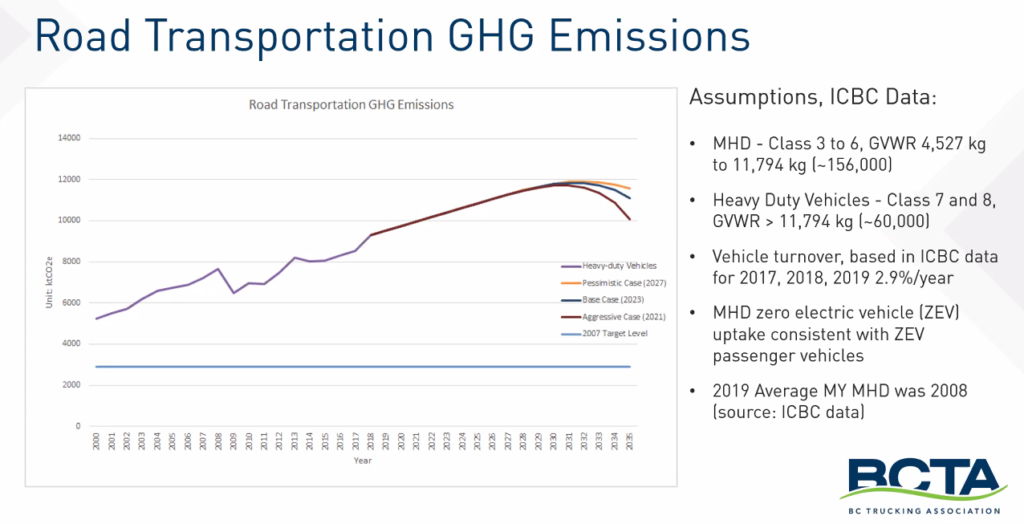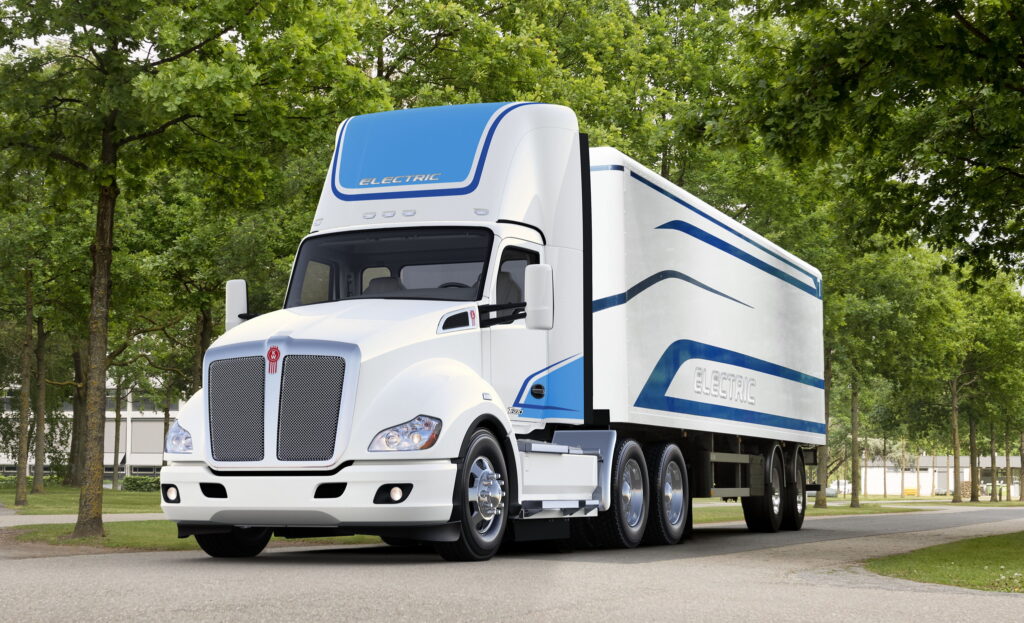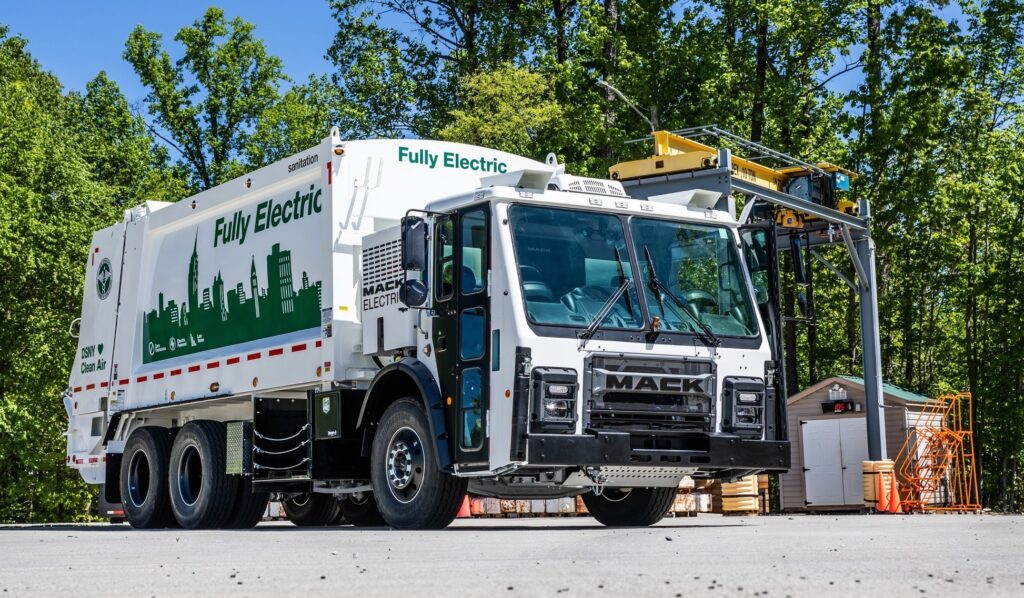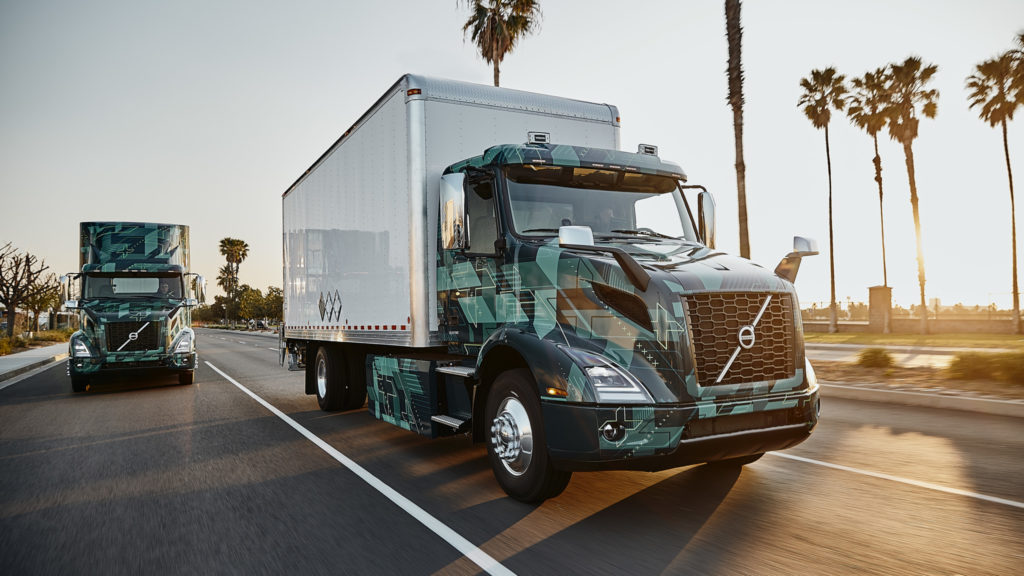Electric trucks the future of zero emissions transport, but more immediate action needed
Zero emission commercial vehicles are the likely answer to trucking industry’s long-term output of greenhouse gases, but they won’t offer an immediate solution.
Dave Earle, CEO of the B.C. Trucking Association (BCTA) said in the short-term, more will have to be achieved using today’s technologies. He was introducing a BCTA virtual event titled Future of Zero Emission Commercial Vehicles.
According to Insurance of British Columbia (ICBC) data, the average commercial vehicle registered in the province is 13 years old, or a 2008 model year. That era of truck didn’t provide word-beating fuel economy.
“With the emissions controls we saw in the 2000s, we saw serious and significant declines and decreases in fuel efficiency,” Earle said. “It was not until 2017 that we actually got back to where we were at the turn of the century.”
The fuel economy and reliability issues incurred by customers of early emissions level trucks were so punitive, many owners resorted to delete kits and gliders powered by pre-emissions engines. But Earle said targeting those trucks today and bringing them to compliance would still increase GHG by 5-15%, since the technologies removed were not yet very efficient.
The B.C. commercial vehicle population numbers 216,000 and turns over at a rate of just 2.9% per year, Earle noted. That means it’ll be a long time before zero emissions trucks hitting the market in small numbers today will displace the current fleet.
“In 2008, we saw the first zero emission light vehicle sold in B.C.,” he said. “Twelve years later, 10% of new car sales in B.C. are now zero emissions. But that does not translate to 10% of the vehicles on the road.”
Instead, he said only about 1.16% of light-duty vehicles in B.C. are zero emissions, despite the current 10% penetration rate. And he expects the same story to be true as the province’s trucking industry begins deploying electric trucks.

“The cold, hard math on this is we are not going to get there by zero emissions vehicles alone,” he said of provincial targets for GHG emissions from the transport sector. “We need to do more with what we have.”
Solutions that can be deployed today include: right-sizing equipment; adopting more readily available alternative fuels such as CNG or LNG; taking advantage of government incentives to buy fuel-saving aftermarket equipment; increasing the use of long combination vehicles; encouraging the acceleration of truck replacement cycles; and piloting, testing and building fueling infrastructure for zero emissions vehicles.
A look at the future
Earle then turned the conversation over to representatives from six OEMs to learn when their respective zero emission commercial vehicles will begin to arrive on Canadian highways.
Alex Voets, sales and marketing manager for future electric trucks with Daimler Trucks North America (DTNA) updated attendees on the company’s Innovation Fleet. It has electric trucks in real-world service, and those trucks are now available for order.
“Not every use case is the right use case for electrification,” Voets acknowledged. “We see incentives as necessary to overcome investments in vehicles and [charging] infrastructure.”
He urged fleets interested in electrification to consider charging requirements early, noting it can take up to 18 months to get the charging infrastructure in place.

Alan Thompson, Canadian region manager for Kenworth, said his company partnered with Dana to develop a medium-duty solution and Meritor for Class 8 applications. This allowed it to quickly bring electric trucks to market.
On the medium side, it offers the K270E and K370E in Classes 6 and 7 configurations, capable of achieving about 200 miles (320 km) of range between charges. Those trucks are suited for P&D and final mile applications.
The T680E is Kenworth’s battery-electric day cab tractor and offers a 150-mile (240 km) range, suitable for P&D, regional and drayage applications. It uses a Meritor e-axle for propulsion with Paccar batteries Thompson said are designed for heavy-duty – not automotive – applications. The truck can produce 536 continuous horsepower at 1,623 lb.-ft. of torque.
Kenworth and Peterbilt both offer Paccar chargers, with the 50 kW DC charger being the most popular, Thompson said.

Quebec-based Lion Electric is the newest player to the truck manufacturing arena, but has been in electrification the longest, according to Yves Provencher, senior manager of business development. Most of its experience until recently came in the bus market.
It has more than 300 electric vehicles on the road today, which have accrued more than three million kilometers. It offers Classes 6 and 8 electric trucks, with an 8T tractor model coming in October capable of handling full Canadian payloads. Classes 5 and 7 models will be added next year.
Provencher said its modular battery design means it can easily adapt battery capacity for a specific duty cycle. Customers need to consider their number of stops, range, and accessorial equipment needs. Hydro Quebec, for instance, needed a range of 150 km, to operate the bucket for five hours a day, and to keep the cab warm for lunch breaks.
“All those things can be optimized for each operation,” said Provencher.
Scott Barraclaugh, senior product manager, e-mobility for Mack Trucks, touted the viability of electrification in refuse applications. Mack has electrified its LR refuse truck for these needs.

“The trucks are running consistent routes, they’re home every night so the charging infrastructure can be centralized and they have ample time to recharge,” he said. “Stopping and going for residential or urban pickups gives lots of opportunities for regenerative braking.”
This process captures braking energy and puts it back into the batteries, extending range while also reducing wear and tear on brakes.
“Refuse trucks eat brakes and we’re hoping to see significant improvements in brake life with these vehicles,” Barraclaugh said.
Matt Wetta, alternative powertrain manager for national accounts with Peterbilt, also cautioned fleets to put electric trucks only into applications that make sense. Its offerings include the 220EV medium-duty, the 579EV day cab, and the 520EV refuse truck.
Range is a big consideration. A diesel-fueled 579 can run about 700 miles (1,120 km) between fill-ups, while an electric version will be limited to about 150 miles (240 km) between charges. A refuse truck may only get 100 miles (160 km) per charge.
Weight is also a factor. A fully fueled diesel 579 may tip the scales at 16,000 lb., while an electric truck could weigh 22,000 lb.
Fleets should calculate the savings over the life of the vehicle, the biggest of which will come from fuel spend. Wetta said a diesel Model 579 may cost $485,000 to fuel over a 10-year life, while an electric truck could cost about 75% less, depending on electricity rates.

Brett Pope, director, electric vehicles with Volvo Trucks North America, said electrification will play a big role in helping the truck maker reach its goal of reducing its CO2 output by 50% by 2030. As part of its LIGHTS project in California, Volvo, which currently offers the VNR Electric, will have about 25 vehicles in operation this summer. The VNR Electric enters production this year, in 4×2, 6×2 adaptive loading, and straight truck configurations.
It’s currently readying its dealer network to support the trucks and will have all Canadian dealers trained by the end of the third quarter, Pope said.
Have your say
This is a moderated forum. Comments will no longer be published unless they are accompanied by a first and last name and a verifiable email address. (Today's Trucking will not publish or share the email address.) Profane language and content deemed to be libelous, racist, or threatening in nature will not be published under any circumstances.
We need a plan to have new truck parking with both electric plugs for heating and cooling of cabs and charging of smaller trucks. This would be a good use of some of the carbon tax. As well. We need to be able to upgrade the 4 or 3 battery pack to a better more expensive batteries for existing trucks and all new trucks should to have backup air-conditioning and heating. All buses as well need to be hybrid as they are being replaced with the ability to recharge from a 20 amp or 15 amp 110 plug. We should plan for this when we take land to build new apartment towers and all warehousing in Ontario and Quebec and B C.